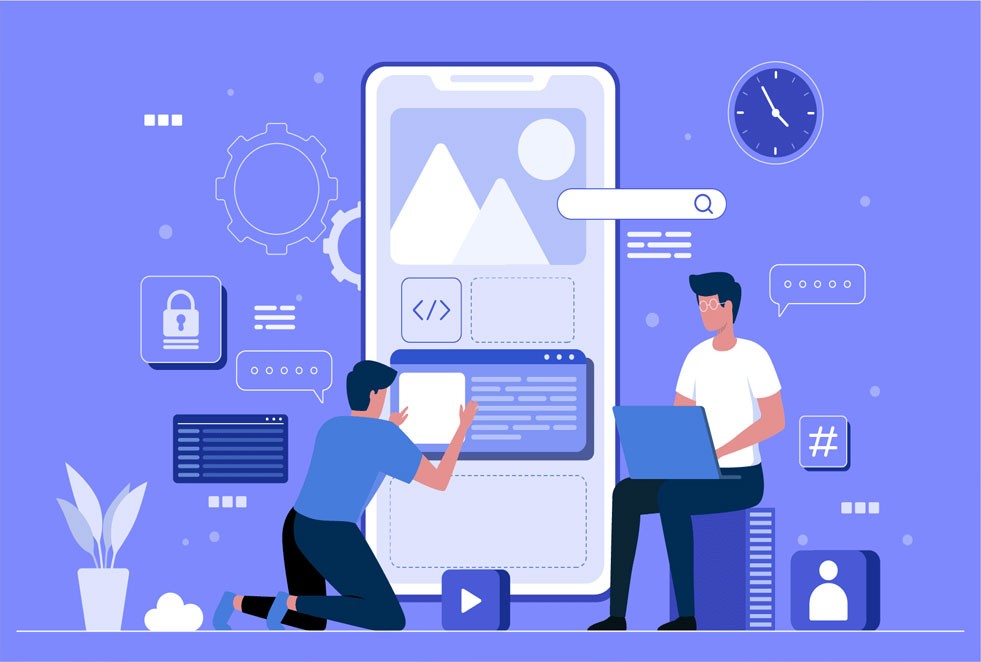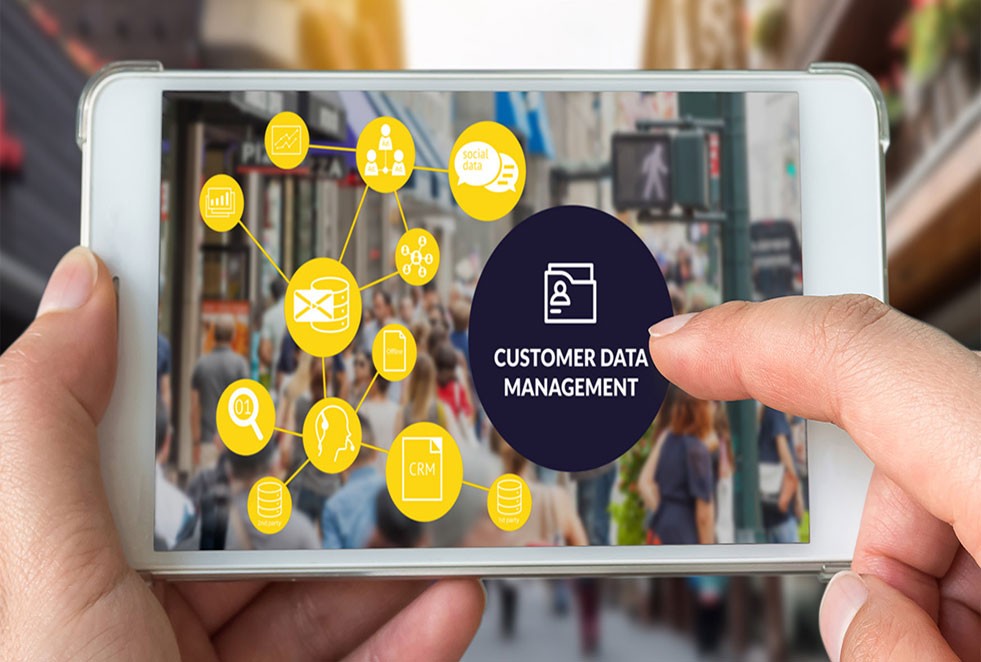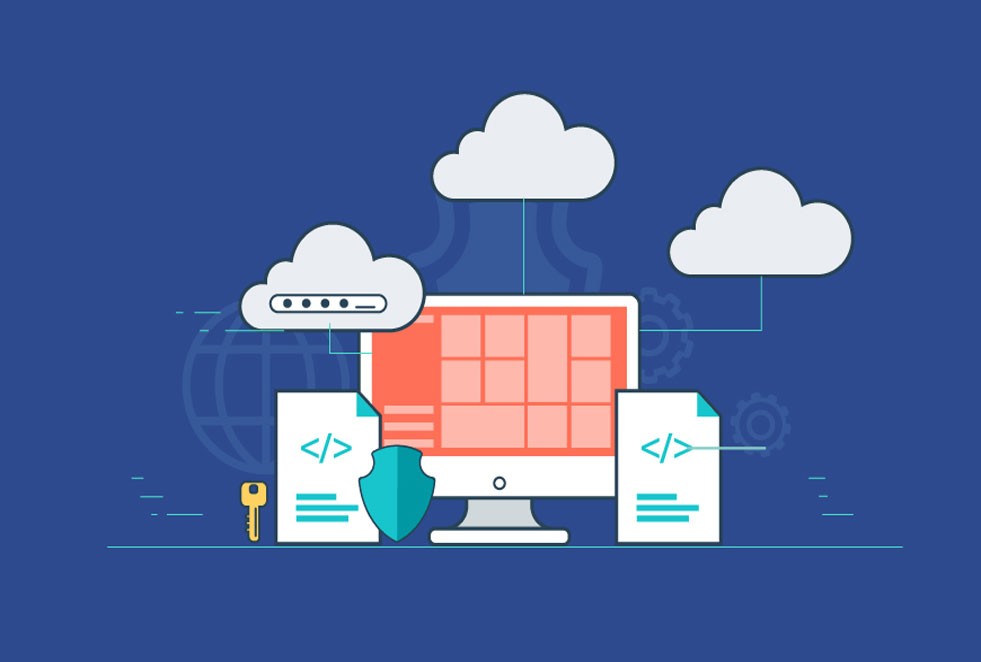Mobile App Development
What is Mobile Development?
Any kind of development for a mobile device is referred to as mobile development. I know that was kind of a rhetorical definition but bear with me. This statement means that creating applications for phones, tablets, smartwatches, and any other types of wearable technology that run mobile operating systems is included in mobile development.
Additionally, it doesn’t always include creating just mobile apps since even web developers nowadays must consider how their applications will be used and accessible on a mobile device.

Mobile Application Development
A typical mobile app uses a network connection to talk to computer resources that are far away. Mobile application development is the process of making software apps that run on mobile devices. As a result, the mobile development process includes building installable software packages (code, binaries, assets, etc.), setting up backend services like data access via an API, and testing the application on target devices.
Mobile Applications and Device Platforms
In the smartphone market, there are two main platforms: Apple’s iOS and Google’s Android. iOS powers Apple’s iPhones, while Android is used by many other companies to create their own devices. Developing apps for these platforms requires separate SDKs and toolchains. Apple exclusively uses iOS for its devices, while Google allows other companies to use Android under certain conditions. Developers can target a vast number of devices by creating apps for both platforms.
Significant Mobile Application Services
Mobile application developers may make use of a vast array of cloud-based and third-party services to accelerate the creation and distribution of their apps. A developer, however, is unlikely to be able to become an authority in each of these particular services. Instead, mobile developers should seek a development environment that enables them to swiftly and simply integrate, apply, and consume the most often needed features into their applications while yet keeping the ability to use the various different services that are offered.
Data Services
- Online Storage
- Offline and Live Data
- The logic for Applications and Cloud Services
Essential
- User Registration, Login, and Management
- Facebook login (Facebook sign-in, Twitter sign-in, etc.)
- Analytics and Participation
- Notifications through Push
- Testing actual devices
Machine Learning
- Talkative robots
- Video and Image Recognition
- Language Recognition
Top Benefits of Mobile Apps Development for Businesses
Accessibility from Different Platforms
You may get access to practically any kind of internet site by creating a mobile app. The creation of apps helps businesses access markets via social networking platforms as well as Blackberry, Google Play, and the Apple App Store. Apps may also provide information to users, evaluate features, offer discount coupons, and make mandatory notifications.


Reach Global Audience
Mobile applications support the development of an effective app marketing strategy and enable firms to connect with a broad target audience.
Expanding Accessibility
Additionally, mobile applications contribute to improving company accessibility. It also makes it easier for firms to build solid relationships with their clients, fostering both real clientele and strong client loyalty. Mobile applications enable consumers to have practical access to the goods, data, procedures, and services they would need in the present. Additionally, it gives the company the ability to notify customers about new or modified goods and services. The applications carry out basic tasks even without an internet connection. Thus, applications substantially improve workplace accessibility.


Promotes Brand Recognition
When achieving the top spot is a company’s ultimate aim, brand recognition is crucial. Companies may easily provide their customers with high-quality services by creating a mobile app.
Encourage Brand Loyalty
Mobile applications assist in informing the administrator of the users’ interest in certain deals and goods. Additionally, it helps management committees create tailored brand loyalty programs for users.


Transform Retail Business & Reduce On-Premise Cost
By providing a distinctive customer experience, mobile applications enable merchants to satisfy consumer expectations and revolutionize the retail experience. Mobile applications are what most companies are built on. This helps to lower the overhead costs related to opening a brick-and-mortar shop.
Facilitate Quick Feedback Management
Customers are provided with a handy platform through mobile applications that enables them to provide feedback on the goods and services they use.


Social Media Integration
The users of your mobile applications may give their comments on numerous social media sites by adding social media icons to the apps. In this approach, a mobile app is regarded as a powerful marketing tool for companies.
Unique Payment & Services
Mobile applications come with special features that are tailored to certain businesses. For instance, your app would be the greatest for your target clients to make an appointment if you work in the service sector, such as healthcare, spa, salon, etc. The preferred method of paying nowadays is through a mobile device. Businesses may include payment options in their apps to enable direct debit and credit card payments for consumers. These payment options are quick, easy to use, and safe.


Quick Access Top Customer Data
You can easily and quickly access consumer data using mobile applications. Businesses have the chance to assess areas for development, the quality of goods and services, etc. by looking at the app’s review section.
Traveling Marketing
With its user-friendly and intuitive assistance, mobile applications let companies sell themselves while they are on the road. An app with a wide range of features offers businesses unique value propositions.


Increase Customer Engagement
Mobile applications let businesses create a direct marketing channel with their clients that enables efficient and direct connection. You can reach as many clients as you want with an app by sending in-app and push alerts. The alerts that provide pertinent and important information connect with your clients and motivate them to stick with your business.
Saves Time
By providing clients with one-touch access and a straightforward purchase procedure, mobile applications make their lives easier. They save time by receiving product and service information immediately.


Allow Staying Ahead of The Curve
With a mobile app, a business may separate out from the competition and make a big profit from influential customers. You may surprise your consumers with original strategies thanks to the applications.
Scheduling
Businesses may now simply plan and schedule appointments that previously required additional staff thanks to mobile applications. Additionally, the software executes the duties automatically, reduces the likelihood of mistakes, and instantly alerts businesses.

What is a Mobile App Framework?
Businesses have shown that the greatest method to increase their consumer base is via mobile apps. There has never been a shortage of innovative app ideas. Everything worked in the application development industry’s favor. You don’t need to know how to use hard programming languages to make an app. There are different frameworks for making apps for both iOS and Android. Simply having a firm knowledge of web-based programming languages like HTML, CSS, or JavaScript will do.
Types of Mobile App Frameworks
These are just a handful of the digital gadgets that are available, along with Android, iOS, and Windows. There are many different sizes and shapes for mobile apps. We’re not talking about certain app features like games or in-app purchases. However, mobile apps may be categorized into three groups based on how they function on a smartphone.
Web Apps
A Web app is a piece of software that is stored remotely and made available online via a browser interface. Emails, online auctions, weblogs, instant messaging applications, and other web programs are widely used.
Native Apps
They are made for certain operating systems, such as Windows, iOS, and Android. The RAM, camera, GPS, and other components of the smartphone are used by apps.
Hybrid Apps
Applications known as hybrid apps may be opened on a smartphone in the same way that other apps can. Hybrids differ from other applications since they integrate elements from online apps and native app capabilities.
The Top 5 Mobile App Development Tools

Eclipse
A well-liked solution that provides a unique coding environment and capabilities to customize the app as needed. It may be utilized for Java applications that make use of the library’s plug-ins. It may now be used for applications based on JavaScript, Python, Ruby, etc. thanks to the modifications. The tool has several incredible capabilities that may aid in growing the codebase.
Android Studio
It is a powerful tool with the most cutting-edge plug-ins and capabilities for creating sophisticated apps. Today, this is the Android app development tool that developers adore the most. The program uses a straightforward interface to provide functionality including code change, troubleshooting, and testing.


AVD Supervisor
Developers may test the device on devices and Android API versions using the Android Virtual Device (AVD), a tool. Testing is made simpler by the tool’s availability of all capabilities found on a genuine Android smartphone. Calls, texts, and other features may be emulated based on the situation.
Android SDK
The Android SDK is a crucial development tool used by all developers. It is an IDE with a variety of tools for managing, writing, testing, and developing apps. This calls for a variety of tools to enable the creation of simple to complex applications. Regardless of the platform you choose, an SDK is required to execute the program across devices.


Unity 3D
A widely used tool by developers all around the world to create Android-powered applications. It has tools that can be used to make both 2D and 3D games. It is a program that provides beautiful images and game development forms. It is often used in the creation of cross-platform video games and websites.
8 Essential Tools & Technologies for Developing Mobile Apps
Node.JS
Today’s front-end developers are spoiled with access to some of the most cutting-edge technology, which has simplified their tasks. Node.JS, which uses non-blocking IO to assist in developing networked programs, has grown into a large ecosystem of tools, libraries, and frameworks. It is now necessary, not an option, to learn Node.
Swift
The finest of C and Objective C are combined to create this new open source programming language for iOS, OS X, watchOS, and tvOS applications. It embraces secure coding practices and incorporates contemporary features to make programming simpler, more adaptable, and more enjoyable. It is the first scripting-like, expressive, and entertaining systems programming language of industrial grade.
Objective C
This object-oriented programming language is general-purpose. It continues to be more well-liked than Swift and is the primary programming language used by Apple for OS X, iOS, and their separate application programming interfaces (APIs). Even though Objective C is an outdated programming language, it still makes up the majority of the code base in most programs.
PhoneGap
This is a well-known framework for building mobile apps that free developers from having to depend on platform-specific APIs like those in iOS, Android, or Windows in order to create applications for mobile devices. The resultant applications are hybrid, which means they are neither native nor web-based, but they also provide an expensive method of creating multi-platform programs.
Appcelerator Titanium
This is an open-source toolkit for creating cross-platform mobile applications. The Appcelerator platform is a mobile engagement platform that offers mobile analytics, mobile test automation, crash detection, and performance monitoring, mobile backend as a service (MBaaS), and cross-platform mobile app development using JavaScript.
DOM Frameworks
A cross-platform and language-independent paradigm for interacting with objects in HTML, XHTML, and XML texts is called the Document Object Model (DOM). JavaScript is necessary to create an interactive mobile website or HTML5-based app. Writing the code in accordance with DOM is the best course of action if the mobile app is relatively simple. DOM frameworks are helpful for network connectivity, animations, and situations where a lot of DOM components are needed.
CSS Frameworks
These pre-made software frameworks are intended to make CSS-based web design simpler and more consistent with industry standards. Most of these frameworks are unobtrusive and design-oriented.
JS Frameworks
Over the last several years, these frameworks have grown in popularity among those who create mobile applications. Frameworks for JavaScript are crucial resources for experienced programmers. JS frameworks and JavaScript libraries provide some important foundations on which to create mobile applications due to their virtually limitless capabilities.
Mobile technology case studies
Increasing output
Amica Mutual Insurance Company estimates that using its Road Day mobile app to submit claims data from the field resulted in productivity benefits for its workflow procedures of between 25 and 50 percent. With the use of the app, adjusters can work directly with clients on the ground, increasing claim accuracy and giving clients a sense of ownership.
Capitalize on new business models
Out of the 240 species of frogs known to exist, 4 are extinct in Australia. Scientists need a quicker data-gathering technique to safeguard them. The FrogID app allows Australians to capture audio of frogs’ distinctive cries and submit them to an internet database as part of a crowdsourcing strategy. The software maps frog populations using GPS data as well.
Create the ideal shopping scenario
Mobile technology is used by City Furniture to offer a nearly perfect shopping experience. Customers may engage with sales representatives and physically touch products while doing online research. Without leaving the customer’s side, sales representatives may access real-time data, handle payments, and plan deliveries using the mobile app they use on their tablets.
Features that make mobile technology work
Scalability
It can be expensive to build, manage, and maintain point solutions that don’t work well across an enterprise. Apps need to be thought of as a whole, taking into account business lines, processes, and technical environments.


Integration
IDC has said (PDF, 611KB) that “there is a separation between the mobile app and the back-end business logic and data services in mobile phone and tablet applications.” Logic and data services must be able to connect to the app. This is true whether the logic and data are on-premises, in the cloud, or in a hybrid configuration.
Reuse
There were more than 105 billion downloads of mobile apps in 2018. Many have business uses or can be changed or put together to make business uses. By taking advantage of the domain and industry knowledge already built into the app, using existing apps speeds up the time to value and reduces costs.


Cloud-based development
The cloud is a good place to build, test, and manage applications. Developers can connect apps to back-end data using application programming interfaces (API) and then focus on front-end functions. They can add authentication to improve security and use artificial intelligence (AI) and cognitive services.
Mobility management
As organizations use more mobile technology, they look to enterprise mobility management (EMM) solutions to set up devices and apps, track device usage and inventories, control and protect data, and help with and fix problems.


Bring your own device or BYOD
BYOD is an IT policy that lets employees access data and systems from their own devices. When done right, BYOD can save money, boost productivity, and make employees happier. At the same time, it raises questions about security and how to keep track of all the devices.
Security
The battle for mobile security is hard to win because it is so big and complicated. Artificial intelligence (AI) is becoming an important tool for finding security flaws in huge amounts of data. From a central dashboard, it can help find and fix malware incidents or suggest steps to take to meet regulatory requirements.


Edge computing
One of the best things about 5G is that it can bring applications closer to the edge servers or data sources that they use. When data is close to where it comes from, the network can get benefits like faster response times and more bandwidth. From a business point of view, edge computing gives you the chance to analyze data more thoroughly and get deeper insights faster.
FAQs
The process of developing software apps for mobile devices is known as mobile app development. You must choose a company that has expertise with all types of mobile applications and uses a tried-and-true development methodology if you want to have a mobile app developed.
Both Android and iOS smartphones and tablets may support the development of mobile applications. Apps may be targeted for usage by customers, staff members, and suppliers.
Yes, in fact almost every mobile app that we develop also requires a web-based application to power it. Ever signed into a mobile app? A web server is running in the background, providing the app with information that it uses to determine whether or not you have the authorization to log in.
The numerous tools, frameworks, components, libraries, and other technologies needed to build apps for mobile devices are referred to as mobile app development technology. Mobile devices include, but are not limited to, smartphones, laptops, tablets, and smartwatches.
This object-oriented programming language has been the preferred and accepted language for creating Android mobile apps since the launch of Android in 2008. Java, a very flexible language, keeps your software extendable, modular, and adaptable.
The adoption of the IoT is one of the major themes for mobile app development in 2021. (Internet of Things). These tendencies ultimately translate into several Android features that enable developers to construct devices on top of well-known hardware platforms like the Raspberry Pi.
As a result, the mobile development process includes building installable software packages (code, binaries, assets, etc.), setting up backend services like data access via an API, and testing the application on target devices.
Technology that travels with the user is called mobile technology. It includes of computer equipment, portable two-way communication devices, and the networking technology that links them. Currently, internet-capable gadgets like smartphones, tablets, and watches best represent mobile technology.
The fifth generation of wireless cellular technology is known as 5G. Although 5G utilizes extremely high frequencies that give higher bandwidth, it utilizes radio spectrum frequencies as 4G does. More data will be sent at faster rates to more devices as a result. Consider a smartphone receiving streaming video.
A mobile application development platform (MADP) is a type of software that lets a business quickly build, test, and possibly deploy mobile apps for smartphones or tablets. A business can either build its own platform for making mobile apps or buy one of the many that are already on the market.
Virtual reality and augmented reality technologies are the new trends in mobile development that are expected to make the user experience on Android and iOS much better in 2022. The global market for AR and VR is expected to reach $30.7 billion in 2021 and close to $300 billion in 2024.
Laptops, tablets, and netbook computers are all examples of mobile IT devices. smartphones. GPS devices help people find their way around.

